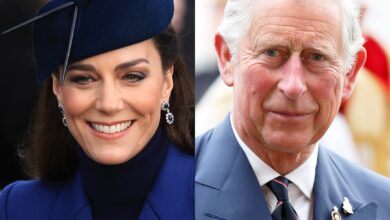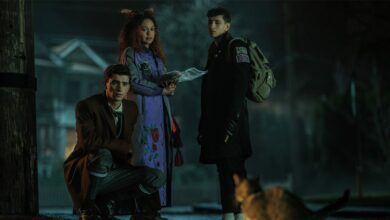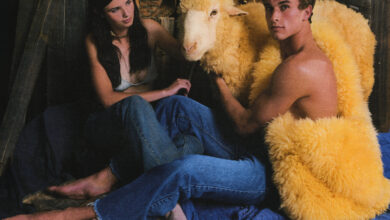Taylor Swift’s ‘Fortnight’: Unpacking the 13 Layers Of Meaning Behind ‘The Tortured Poets Department’ Fashion
Braver journalists than I have taken it upon themselves to decode the 31 tracks of Taylor Swift’s The Tortured Poets Department (yes, the lack of apostrophe does bother me), looking, by turns, for reported references to Matty Healy (a wholly unconvincing “golden retriever”), Joe Alwyn (who clearly doesn’t appreciate the real estate value of a “house by the Heath”), and “the Christian chorus line” that is, presumably, the Kardashian clan.
Allow me, then, to home in on the “Fortnight” video—specifically the diamond watch choker that Swift wears while visiting what looks like the same (ethically questionable, Severance-esque) clinic featured in Ariana Grande’s “We Can’t Be Friends.” This being Swift, of course, said necklace is no mere necklace; it is the fine jewelry equivalent of the White Rabbit, a portal to an alternate Swiftian universe where everyone’s obsessed with Via Carota and John Mayer has precisely zero redeeming qualities.
But I digress. Swift’s most obvious reference here is Clara Bow, whose biography and aesthetic echo throughout The Tortured Poets Department’s lyrics and accompanying visuals, with track 16 using her story as a metaphor for the fickleness of fame, the ephemerality of entertainers (“You look like Clara Bow / In this light, remarkable / All your life, did you know / You’d be picked like a rose?”)
Bow, a Brooklyn-born ingenue, became a silver-screen darling in the ’20s by way of 46 silent films, 11 talkies and five broken engagements in five years. She finally married Rex Bell, a Western star who later became Lieutenant Governor of Nevada (never change, America), and retreated to his Mojave Desert ranch, although not before she had delivered the immortal line: “I cannot marry Harry Richman as I am expecting a nervous breakdown.”
Bow, circa 1925, in a choker decidedly similar to the one Swift wears in “Fortnight”.
Eugene Robert Richee/Getty Images
It’s Bow, too, who gave rise to the fashion industry’s most overused term bar iconic: “It-girl.” The epithet derives from her 1927 film, It, in which she plays a retail assistant whose ineffable charms enable her to seduce Cyrus T Waltham, heir to a department store fortune. (Clowns, mercifully, do not feature). As for who invented the concept of a certain It-factor: that would be Rudyard Kipling, of all people, in his short story “Mrs Bathurst”: “Tisn’t beauty, so to speak, nor good talk necessarily. It’s just It. Some women’ll stay in a man’s memory if they once walked down a street.”
TLDR: Bow was a national obsession in her day, which played a role in her complete nervous collapse in 1931. She would spend much of the rest of her life in and out of psychiatric wards, undergoing periodic shock treatments (a fact alluded to in the “Fortnight” video), but by the time of her retirement at the age of 28, she had already become a symbol of the Jazz Age. As the New York Times wrote in its 1965 obituary: “More than any other woman entertainer of her time, Clara Bow perhaps personified the giddier aspects of an unreal era, the Roaring Twenties.
Hollywood’s contribution to the period of bathtub gin and flappers was a series of appropriate movies and the emergence of such cinema queens as Pola Negri, Constance Bennett, Gloria Swanson and Kay Francis. But America frankly preferred the vibrant earthiness of the little young redhead from Brooklyn.” Vogue put it another way: “There were shoals of It-girls, but Clara Bow was It.” Which, a century later, is a sentence that could easily be applied to Taylor Swift.
Taylor first nodded to Bow at the 2024 Grammys when she wore a vintage Concord watch reimagined as a choker by Lorraine Schwartz (along with 300 carats worth of diamonds and a Schiaparelli gown). Chokers weren’t a hallmark of Bow’s per se, but they were en vogue in the ’20s, particularly heavier, art-deco styles that complemented the era’s sleek flapper bobs. Fast forward to the “Fortnight” video, and Taylor leaned heavily into Bow’s beauty signatures: finger waves, barely there eyebrows, scarlet pout. (It’s a look that Swift first experimented with in the pages of British Vogue during a January 2018 shoot with Mert + Marcus, with Isamaya Ffrench responsible for her ’20s transformation.)
Nods to Victorian mourning can be found throughout the “Fortnight” visuals.
YouTube/Taylor Swift
In lieu of recycling her Grammys timepiece for her pas de deux with Post Malone, Swift selected another watch to suspend from a blush-toned velvet choker: a pendant courtesy of Joseph Saidian & Sons. Based in Manhattan, the fourth-generation jewelers trade in precious metal masterpieces and haute joaillerie, from the Westminster Halo Tiara to Brooke Astor’s emerald Van Cleef & Arpels bracelet. It’s also the Midtown stalwart who provided the three glittering brooches that were pinned to Rihanna’s scarlet Loewe tracksuit during her Super Bowl performance, and while I’m not suggesting this means Swift is confirmed for the 2025 Halftime Show… would anyone be surprised if she is?
Perhaps more pertinently for an album littered with references to heartbreak, death and mourning, the practice of wearing watches as necklaces can be traced back to the First World War (a conflict that rumbled on throughout Bow’s teenage years). At the close of the Edwardian era, when soldiers left to go to the front, it became commonplace for them to leave behind pocket watches and Albert chains with the women they loved, who would wear them around their necks, either to keep the men in the trenches physically close to their hearts or top of mind if they were killed in action.
Then there’s the Victorian custom of stopping every clock in the house at the exact time of a family member’s death. Taylor not only references the 1830s in “I Hate It Here,” but also wears an ebony mourning dress in a Victorian silhouette in the “Fortnight” video, while a sense of time having ground to a halt in the wake of a relationship’s break down recurs throughout TTPD (“All my mornings are Mondays, stuck in an endless February”). Time, in Taylor’s dimension, is a flat circle—which goes a long way towards explaining why Swifties are rehashing decades-old drama over “thanK you aIMee.”




